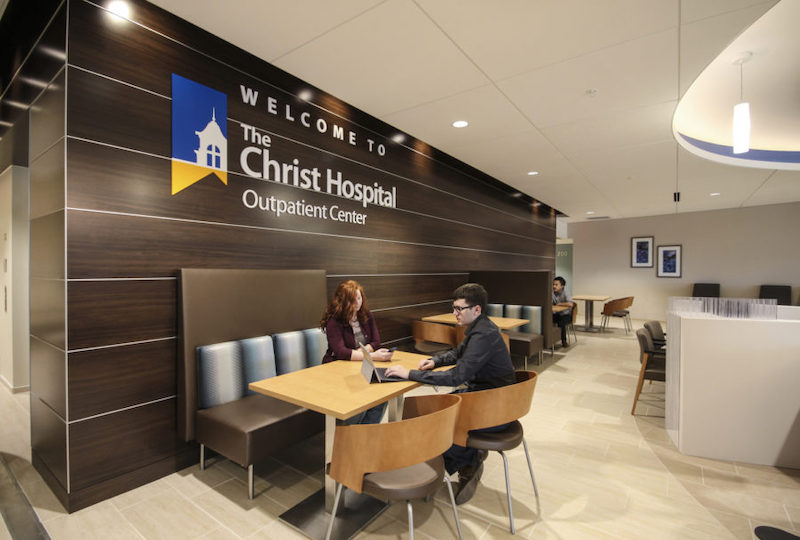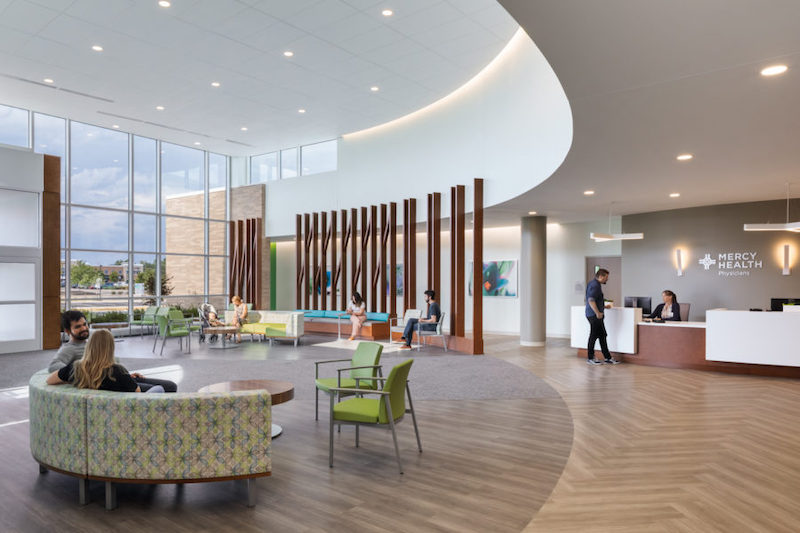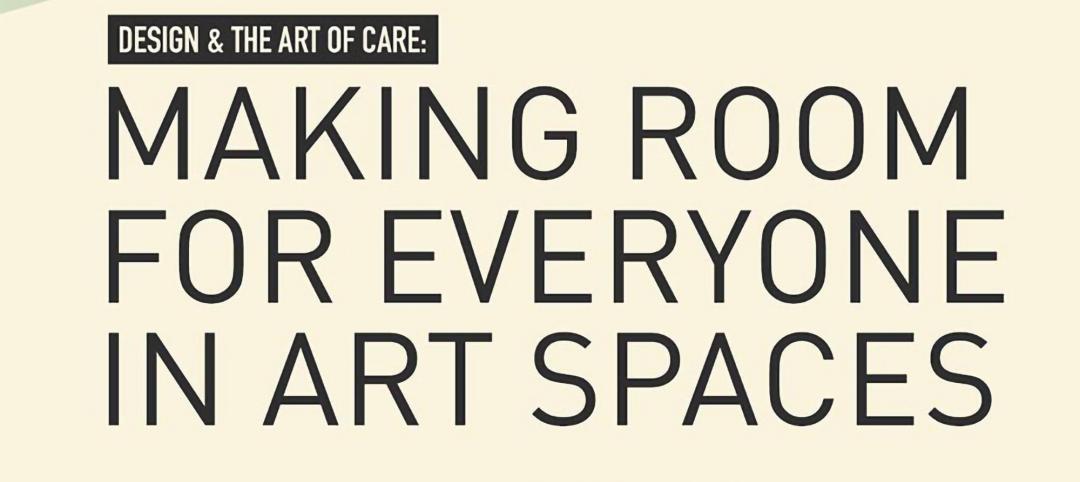In ambulatory facility design, human interaction and empathy are more important than ever. For years, designers and healthcare institutions have been working together to improve the patient experience, including significant focus on the registration and waiting process. However, delivering care in the COVID era has highlighted why changes are imperative. More than patient perception is at stake. Changing how patients register and wait for appointments will enhance the healthcare industry’s ability to respond to crises.
There is an opportunity to transform the waiting experience so waiting time is not wasted time.

Leveraging technology is key. Healthcare systems across the country are already using technology in safe and effective ways. Over the past year many people have grown accustomed to checking in on their own phone from the parking lot. Why go back to the old way— walking into a registration area, sharing screens, pens, and papers with every other patient to fill out pre-visit paperwork? Does anyone want to go back to sitting elbow to elbow with a stranger while waiting for an appointment, or while a loved one is in surgery? We can use the lesson of the COVID pandemic to evolve the process; to help patients and providers make the most of their face-to-face time by focusing on simplicity, choice, and personal interaction that builds confidence and comfort.
The push to improve the waiting experience is not new; focusing on how the patient feels and perceives an organization based on the “look and feel” of the waiting room has been a priority for an increasing number of organizations. But the obvious health risks of the tight proximity that many waiting rooms often pose to patients and families brings a new urgency to the waiting experience. Removing chairs— or worse yet—taping off chairs in a waiting room to accommodate social distancing highlights just one of the struggles that needs to be overcome in the waiting experience. GBBN has been working closely with our clients to deploy research-based solutions to enhance waiting spaces. These solutions improve the patient and family experience as well as the efficiency of the space. GBBN’s own research on proxemics and our in-person observations have shown that a variety of seating types and small clusters within a waiting space accommodate the needs and number of people by providing seating choices and clear lines of sight.
Simulation software can help drive efficient design and patient comfort

As designers and planners, we rely not only on qualitative data like observations and surveys; we also employ quantitative data for a well-rounded approach to design. “With the help of simulation software, we can input data points like frequency of patient arrivals, length of appointment, quantity of exam rooms, and number of providers and staff to help inform our planning,” says GBBN’s Amy Mees, a medical planner and healthcare designer who works closely with organizations like Cincinnati Children’s, TriHealth, and Bon Secours Mercy Health. “We can run scenarios that drill down to what we’re trying to accomplish with our planning,” she explains. “For instance, we may want to understand the number of patients and families that will occupy the waiting area throughout the day. Our studies can help an organization’s management team modify their operations to smooth out the peaks and valleys that occur day to day.”
COVID has increased the use of telehealth with increased televisits among patients and providers. Last year, the Kaiser Family Foundation reported the results of a national poll that showed a 23% increase in the number of adults who used telehealth services, a significant increase over prior years. The rise of telehealth will also have an impact on the in-person waiting volume and experience at ambulatory facilities. “There are strong operational impacts depending on which telehealth model organizations choose to implement,” says Tim Hsu, GBBN’s healthcare market research strategist. “Simulation software lets us test all the variables virtually to help surface the right design solution for a facility. Simulation can reveal inefficiencies in how patients are roomed in ambulatory clinics,” says Hsu. “We can test different scenarios by looking at how many patients and providers are physically using the space, and what kinds of space providers need for telehealth care,” he explains.
The most comforting element in waiting spaces is still human interaction and connection

One critical element that should not be overshadowed by use of technology and the need for safety: the importance of human interaction and personal connections in reception and waiting spaces. When humans feel stress, anxiety, or uncertainty, our sympathetic nervous system sends us into a defensive state of fight, flight, or freeze. The people around us in these moments can have a real impact on what happens next. Neuroscientist Stephen Porges described this physiological process in a recent issue of Psychology Today: “Without thinking about it, we pick up nonverbal cues that tell us whether the person we’re interacting with is a friend or a foe. Our heart rate, perspiration, and respiration send those signals in a process called neuroception.”
Connecting with each other in person allows us to make eye contact, read body language, and pick up on other non-verbal cues. This helps put us at ease. In-person/face-to-face interactions help us understand one another; they help us truly see one another and be seen; and they help foster empathy. While technology may streamline the registration process, it won’t eliminate the need for people. “Digital healthcare services are here to stay,” says GBBN Research Director, Charlotte Horseman. “Patients will benefit from the efficiency and safety, but there is plenty of evidence to support the physical and emotional benefits of in-person interaction,” she says. Findings from a three-year study of general practice medicine in the United Kingdom suggest that as a first point-of-contact, clinic receptionists perform complex forms of emotion management to facilitate effective care. Person-to-person communication supports both the patient and an organization’s commitment to caring for the whole person.
In healthcare there is always another risk that can threaten to upend a system’s established processes or sideline a particular facility. Leveraging technology is as important in how your patients access care as it is for building operations and asset management. But technology must be combined with the compassion and empathy of human interaction. Using design to harness the power of both helps patients and families feel comfortable.
More from Author
GBBN | Sep 12, 2024
How space supports programming changes at university libraries
GBBN Associate Sarah Kusuma Rubritz, AIA, uses the University of Pittsburgh's Hillman Library to showcase how libraries are transforming to support students’ needs.
GBBN | Jul 3, 2024
New science, old buildings: Renovating for efficiency, flexibility, and connection
What does the research space of the future look like? And can it be housed in older buildings—or does it require new construction?
GBBN | Jun 3, 2024
Insights for working well in a hybrid world
GBBN Principal and Interior Designer Beth Latto, NCIDQ, LEED AP, ID+C, WELL AP, share a few takeaways, insights, and lessons learned from a recent Post Occupancy Evaluation of the firm's Cincinnati, Ohio, office.
GBBN | Feb 26, 2024
GBBN's Inflation Reduction Act Calculator goes live
GBBN has publicly released its IRA Calculator, a tool that helps you understand funding opportunities in the IRA for sustainable design.
GBBN | Jan 25, 2024
Tactical issues for renovating university research buildings
Matthew Plecity, AIA, ASLA, Principal, GBBN, highlights the connection between the built environment and laboratory research, and weighs the benefits of renovation vs. new construction.
GBBN | Dec 14, 2023
What's next for affordable housing in 2024?
As 2023 draws to a close, GBBN’s Mary Jo Minerich and Amanda Markovic, AIA sat down to talk about the future. What’s next in terms of trends, technology, and construction of affordable housing?
GBBN | Oct 11, 2023
Leveraging land and light to enhance patient care
GBBN interior designer Kristin Greeley shares insights from the firm's latest project: a cancer center in Santa Fe, N.M.
GBBN | Aug 31, 2023
Small town takes over big box
GBBN associate Claire Shafer, AIA, breaks down the firm's recreational adaptive reuse project for a small Indiana town.
GBBN | Jun 20, 2023
Designing arts spaces that curate inclusivity
GBBN's Julia Clements and Marcene Kinney, AIA, LEED AP, talk tips for designing inclusive arts spaces.
GBBN | Mar 22, 2023
Onsite prefabrication for healthcare construction: It's more than a process, it's a partnership
Prefabrication can help project teams navigate an uncertain market. GBBN's Mickey LeRoy, AIA, ACHA, LEED AP, explains the difference between onsite and offsite prefabrication methods for healthcare construction projects.
















